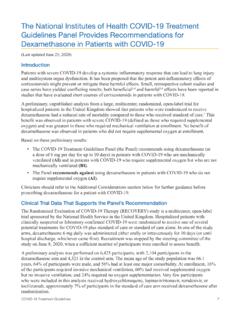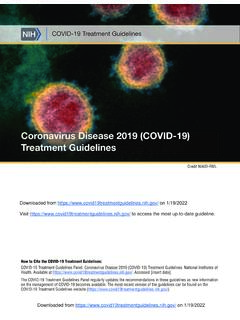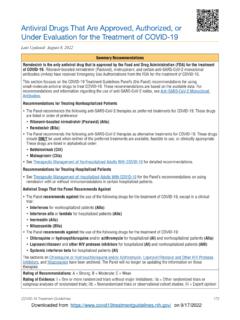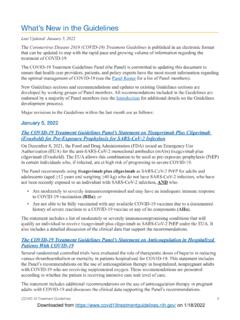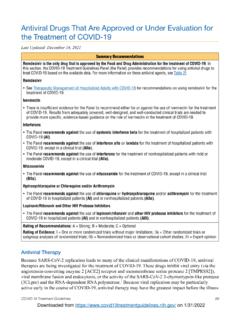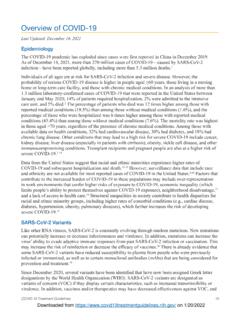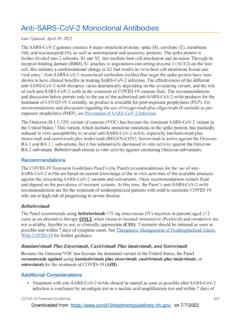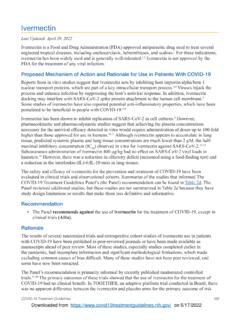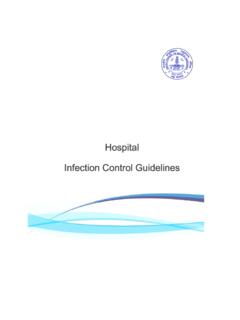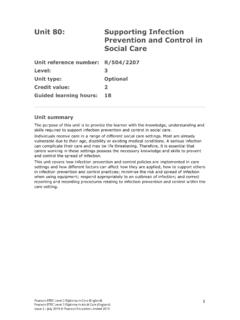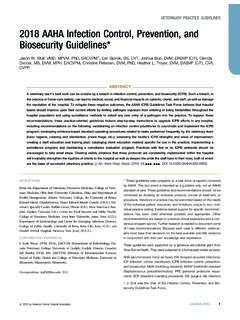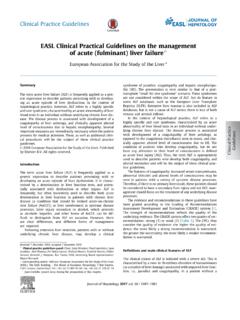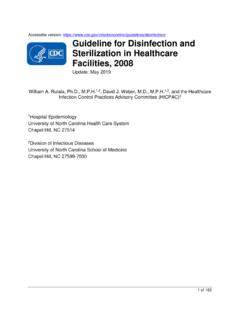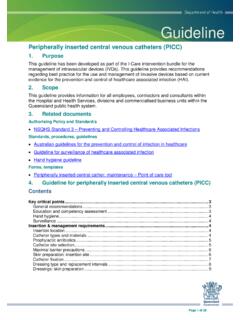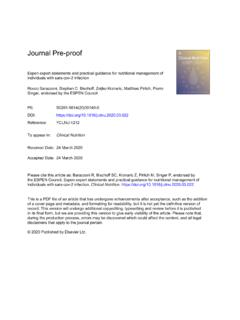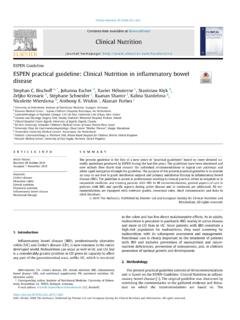Transcription of Last Updated: December 16, 2021 - National Institutes of ...
1 covid -19 Treatment guidelines 70 Care of Critically Ill Adult Patients With covid -19 Last Updated: December 16, 2021 Summary RecommendationsInfection Control For health care workers who are performing aerosol-generating procedures on patients with covid -19, the covid -19 Treatment guidelines Panel (the Panel) recommends using an N95 respirator (or equivalent or higher-level respirator) rather than surgical masks, in addition to other personal protective equipment (PPE) ( , gloves, gown, and eye protection, such as a face shield or safety goggles) (AIII). The Panel recommends minimizing the use of aerosol-generating procedures on intensive care unit patients with covid -19 and carrying out any necessary aerosol-generating procedures in a negative-pressure room, also known as an airborne infection isolation room, when available (AIII).
2 For health care workers who are providing usual care for nonventilated patients with covid -19, the Panel recommends using an N95 respirator (or equivalent or higher-level respirator) or a surgical mask in addition to other PPE ( , gloves, gown, and eye protection, such as a face shield or safety goggles) (AIIa). For health care workers who are performing non-aerosol-generating procedures on patients with covid -19 who are on closed-circuit mechanical ventilation, the Panel recommends using an N95 respirator (or equivalent or higher-level respirator) in addition to other PPE ( , gloves, gown, and eye protection, such as a face shield or safety goggles) because ventilator circuits may become disrupted unexpectedly (BIII).
3 The Panel recommends that endotracheal intubation in patients with covid -19 be performed by health care providers with extensive airway management experience, if possible (AIII). The Panel recommends that intubation be performed using video laryngoscopy, if possible (CIIa).Hemodynamics For adults with covid -19 and shock, the Panel recommends using dynamic parameters, skin temperature, capillary refilling time, and/or lactate levels over static parameters to assess fluid responsiveness (BIIa). For the acute resuscitation of adults with covid -19 and shock, the Panel recommends using buffered/balanced crystalloids over unbalanced crystalloids (BIIa).
4 For the acute resuscitation of adults with covid -19 and shock, the Panel recommends against the initial use of albumin for resuscitation (BI). For adults with covid -19 and shock, the Panel recommends norepinephrine as the first-line vasopressor (AI). For adults with covid -19 and shock, the Panel recommends titrating vasoactive agents to target a mean arterial pressure (MAP) of 60 to 65 mm Hg over higher MAP targets (BI). The Panel recommends against using hydroxyethyl starches for intravascular volume replacement in patients with sepsis or septic shock (AI). When norepinephrine is available, the Panel recommends against using dopamine for patients with covid -19 and shock (AI).
5 As a second-line vasopressor, the Panel recommends adding either vasopressin (up to units/min) (BIIa) or epinephrine (BIIb) to norepinephrine to raise MAP to target or adding vasopressin (up to units/min) (BIIa) to decrease norepinephrine dosage. The Panel recommends against using low-dose dopamine for renal protection (AI). The Panel recommends using dobutamine in patients who show evidence of cardiac dysfunction and persistent hypoperfusion despite adequate fluid loading and the use of vasopressor agents (BIII). The Panel recommends that all patients who require vasopressors have an arterial catheter placed as soon as practical , if the resources to do so are available (BIII).
6 For adults with refractory septic shock who have completed a course of corticosteroids to treat their covid -19, the Panel recommends using low-dose corticosteroid therapy ( shock-reversal ) over no corticosteroid therapy (BIIa).Oxygenation and Ventilation For adults with covid -19 and acute hypoxemic respiratory failure despite conventional oxygen therapy, the Panel recommends high-flow nasal cannula (HFNC) oxygen over noninvasive ventilation (NIV) (BIIa).Downloaded from on 1/21/2022 covid -19 Treatment guidelines 71 For adults with covid -19 and acute hypoxemic respiratory failure who do not have an indication for endotracheal intubation and for whom HFNC oxygen is not available, the Panel recommends performing a closely monitored trial of NIV (BIIa).
7 For adults with persistent hypoxemia who require HFNC oxygen and for whom endotracheal intubation is not indicated, the Panel recommends a trial of awake prone positioning (BIIa). The Panel recommends against using awake prone positioning as a rescue therapy for refractory hypoxemia to avoid intubation in patients who otherwise meet the indications for intubation and mechanical ventilation (AIII). If intubation becomes necessary, the procedure should be performed by an experienced practitioner in a controlled setting due to the enhanced risk of exposing health care practitioners to SARS-CoV-2 during intubation (AIII). For mechanically ventilated adults with covid -19 and acute respiratory distress syndrome (ARDS): The Panel recommends using low tidal volume (VT) ventilation (VT 4 8 mL/kg of predicted body weight) over higher VT ventilation (VT >8 mL/kg) (AI).
8 The Panel recommends targeting plateau pressures of <30 cm H2O (AIIa). The Panel recommends using a conservative fluid strategy over a liberal fluid strategy (BIIa). The Panel recommends against the routine use of inhaled nitric oxide (AIIa). For mechanically ventilated adults with covid -19 and moderate to severe ARDS: The Panel recommends using a higher positive end-expiratory pressure (PEEP) strategy over a lower PEEP strategy (BIIa). For mechanically ventilated adults with covid -19 and refractory hypoxemia despite optimized ventilation, the Panel recommends prone ventilation for 12 to 16 hours per day over no prone ventilation (BIIa). The Panel recommends using, as needed, intermittent boluses of neuromuscular blocking agents (NMBAs) or a continuous NMBA infusion to facilitate protective lung ventilation (BIIa).
9 In the event of persistent patient-ventilator dyssynchrony, or in cases where a patient requires ongoing deep sedation, prone ventilation, or persistently high plateau pressures, the Panel recommends using a continuous NMBA infusion for up to 48 hours, as long as the patient s anxiety and pain can be adequately monitored and controlled (BIII). For mechanically ventilated adults with covid -19, severe ARDS, and hypoxemia despite optimized ventilation and other rescue strategies: The Panel recommends using recruitment maneuvers rather than not using recruitment maneuvers (CIIa). If recruitment maneuvers are used, the Panel recommends against using staircase (incremental PEEP) recruitment maneuvers (AIIa).
10 The Panel recommends using an inhaled pulmonary vasodilator as a rescue therapy; if no rapid improvement in oxygenation is observed, the treatment should be tapered off (CIII).Acute Kidney Injury and Renal Replacement Therapy For critically ill patients with covid -19 who have acute kidney injury and who develop indications for renal replacement therapy, the Panel recommends continuous renal replacement therapy (CRRT), if available (BIII). If CRRT is not available or not possible due to limited resources, the Panel recommends prolonged intermittent renal replacement therapy rather than intermittent hemodialysis (BIII).Pharmacologic Interventions In patients with covid -19 and severe or critical illness, there is insufficient evidence for the Panel to recommend either for or against the use of empiric broad-spectrum antimicrobial therapy in the absence of another indication.
